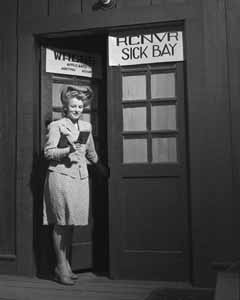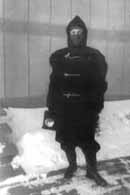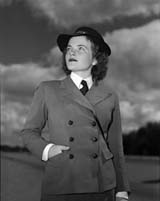WRCNS Uniforms
Getting Kitted Out
Getting Kitted Out

Wren Rosamond Fiddes Greer (nicknamed ‘Fiddy’) poses in civilian clothing for a WRCNS recruting photo, May 14 1943. Photo HN-412 from the former National Defence Image Libary.
Rosamond “Fiddy” Greer well remembers the sense of belonging that came with putting on her wartime uniform for the Women’s Royal Canadian Naval Service (WRCNS):
“Somehow the donning of a uniform seemed to change us. No longer were we salesgirls, stenographers, bookkeepers, waitresses – or even Russian princesses (there were two): we were transformed into a sameness that affected strong feelings of camaraderie and unity. We were Wrens … and we were very proud of it.”
Standardization and regulation of the Wrens’ garb was an evolving process. Just as it took time for the Navy to recruit, organize, accommodate and train women for the WRCNS, it also took time to devise a uniform. The first Wrens to undergo training were dressed in the only uniform then available, a heavy wrap-around blue smock.
In her memoir, The Girls of the King’s Navy, Rosamond Greer wryly recalls her first kitting out as a Probationary Wren or ‘probie’ in 1943, and some of the items she received:
“Shortly after my arrival at Conestoga, I was issued what seemed to be enough clothing to last through a very long war indeed. My gear included:

Elsie Michaels, Alice Adams and Mary Black share a laugh at the unglamorous winter gear issued to Wrens. The over-the-shoe boots were considered “efficient but dreadful.”
“During our probationary days, the work smock was the most useful article in the entire wardrobe” notes Greer. Like other Probationary Wrens reporting for training at the WRCNS training establishment at Galt, Ontario (known as HMCS CONESTOGA), Greer brought with her enough civilian clothing to last a week, including “serviceable underclothing”, since no underwear was provided (although a grant of $5 was given in lieu.)
“What one wore from then on was referred to as ‘Rig-of-the-Day’, and depended on what activity one was involved in,” Greer recalls. The Rig-of-the-Day varied considerably, depending on the individual Wrens’ job categories and other factors.
By the Spring of 1944, four West Coast Wrens working as signallers were officially permitted to wear bell-bottomed trousers. According to Naval Orders circa 1944, Communications Branch personnel within the Wrens could wear trousers of uniform-issue serge. Wrens working in remote outposts may have adopted the sensible option of wearing mens’ trousers long before these items were officially sanctioned by Ottawa.

Wren Lavinia ‘Vin’ Crane is wearing typical cold weather gear issued to Wren telegraphers (special operations) posted to HMCS COVERDALE, Moncton, New Brunswick.
In winter, Lavinia ‘Vin’ Crane and her colleagues at HMCS COVERDALE, Moncton, New Brunswick, faced a trek of half a mile or more to the shacks where they used HFDF (high frequency direction finding) equipment to help locate enemy submarines. Wrens braving cold weather conditions were entitled to the loan of winter caps, long oilskin coats, knee-high rubber boots and parkas. Motor Drivers (MTs) received winter trousers, a turtleneck sweater and two pairs of black cashmere stockings, a necessary luxury for work in sub-zero temperatures (regular winter issue stockings were made of black cotton).
Headgear worn by the Wrens varied considerably over the short years of the wartime service, as Wren 1578, Elsa Lessard observes. “The first hat issued had a brim, replaced fairly soon with the ‘round rig’ and in 1943, a lovely tricorne hat for walking out”. The tricorne was worn on all official occasions and when ordered by the Commanding Officer. It could also be worn off duty. The summer version of the tricorne was black felt, and in winter, black velour. Blue cloth berets were issued to ratings; they were to be worn while on duty, dipped over the right eye at an angle of 15 degrees.

Wren Hemphreys in the summer uniform of the WRCNS, 15 August 1943. Photo R-430 from the museum’s collection.
One significant difference between Wren officers’ and male officers’ uniforms was the braid designating their rank. Wren officers’ rank was signified by sky-blue stripes with a diamond-shaped loop, and male officers’ rank was signified by gold braid and a circular loop. This difference first arose with the parent organization of the WRCNS, the British Wrens (WRNS). Their officers were forbidden to wear gold lace during the First World War ‘because of the wasting of gold’ – gold lace was considered a male prerogative.
The order and discipline inherent in the service life was sometimes a challenge and a revelation for the women who submitted to its rigours, as Rosamond Greer recollects:
“Immediately after being kitted out we were provided with a diagram showing the exact position in which each items was to be placed upon a lower bunk during an operation called Kit Muster…”
“My mother would have been ecstatic had she been able to view my possessions in such orderly array. The civilian person who had been me had never been able to find two matching socks and had found the floor to be the most convenient spot for any clothing removed.”
By Clare Sharpe
Museum staff member/webmaster
1944
This photo appeared in the Vancouver Daily Province newspaper on Wednesday, April 19, 1944, and was captioned as follows:
“No wonder this husky sailor seems slightly puzzled. He has just spied a Wren wearing, of all things, bell-bottomed trousers!”
The once strictly male attire was approved as official working uniform for Wrens on duty as signallers. Signalwoman Madge Foster of Vancouver was one of four west-coast Wrens entitled to wear them.
Stationed at a west-coast naval base, Foster sent and received important navy messages in code and cypher. The sailor is Yeoman Walter Clements of Saskatoon, who worked with the Wren Signalwomen.
Articles
Hours
7 Days a Week: 10:00 am – 3:30 pm
Monday to Friday: 10:00 am – 3:30 pm
Hours
Monday to Friday: 8:00 am – 4:00 pm
To confirm if we are open, please call (250) 363-5655 or (250) 363-4312
Naval & Military Museum
Info@NavalAndMilitaryMuseum.org
CFB ESQUIMALT NAVAL & MILITARY MUSEUM
PO Box 17000 Stn Forces
Victoria, BC V9A 7N2